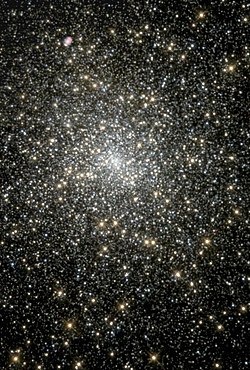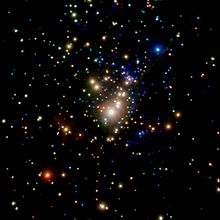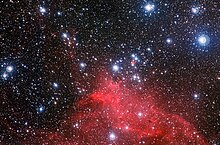Звездано јато

Звездано јато је бројнији (барем пар десетина чланова) систем звезда у галаксији које су гравитациони везане. Битно за звездана јата јесте чињеница да су звезде у једном јату настале готово истовремено, што значи да имају исти хемијски састав.
Подела[уреди | уреди извор]
Постоје две врсте звезданих јата:
- Збијена (глобуларна, кугласта, затворена) јата
- Расејана (отворена) јата
Збијена јата[уреди | уреди извор]
Збијена (или глобуларна, кугласта, затворена) звездана јата су велики системи звезда који садрже од неколико стотина па до више стотина хиљада чланова. То су веома стари системи које су настајали заједно са формирањем галаксија. Што значи да им старост иде и до 13 милијарди година, па се у њима налазе веома старе звезде. Налазе се у халоу галаксије и гравитационо су изузетно стабилна.
Расејана јата[уреди | уреди извор]
Расејана или отворена јата су мања од глобуларних јата. Садрже до неколико стотина звезда. То су млади системи звезда са младим звездама, старости до неколико милиона година. Гравитационо су нестабилна и временом звезде полако напуштају систем, и због тога се временом расипају. Налазе се само у диску галаксије. Врло често се налазе у маглини гаса од које је и настало јато (види слику десно).
Отворени кластер[уреди | уреди извор]

Отворена јата се веома разликују од глобуларних јата. За разлику од сферно распоређених глобулара, они су ограничени на галактичку раван и скоро увек се налазе унутар спиралних кракова. Они су генерално млади објекти, стари до неколико десетина милиона година, са неколико ретких изузетака старих неколико милијарди година, као што је Месје 67 (најближи и најзапаженији стари отворени скуп), на пример.[1] Они формирају H II регионе као што је Орионова маглина.
Успостављање прецизних растојања до отворених кластера омогућава калибрацију односа период-светлост коју показују променљиве звезде Цефеида, које се затим користе као стандардне удаљености. Кефеиде су светле и могу се користити за утврђивање удаљености до удаљених галаксија и брзине ширења свемира (Хаблова константа). Заиста, отворено јато NGC 7790 садржи три класичне Кефеиде које су кључне за такве напоре.[2][3]
Уграђено јато[уреди | уреди извор]


Уграђена јата су групе веома младих звезда које су делимично или потпуно обложене међузвезданом прашином или гасом који је често непропустан за оптичка посматрања. Уграђени кластери се формирају у молекуларним облацима, када облаци почну да се урушавају и формирају звезде. У овим јатима често постоји стално формирање звезда, тако да уграђена јата могу бити дом за различите типове младих звезданих објеката укључујући протозвезде и звезде предглавног низа. Пример уграђеног кластера је Трапезијумско јато у Орионовој маглини. У региону језгра облака ρ Офиучи (Л1688) постоји уграђено јато.[4]
Уграђена фаза јата може трајати неколико милиона година, након чега се гас у облаку исцрпљује формирањем звезда или се распршује услед радијационог притиска, звезданих ветрова и излива или експлозија супернове. Генерално, мање од 30% масе облака се претвара у звезде пре него што се облак распрши, али ова фракција може бити већа у посебно густим деловима облака. Са губитком масе у облаку, енергија система се мења, што често доводи до прекида звезданог јата. Већина младих уграђених кластера се распршује убрзо након завршетка формирања звезда.[5]
Отворена јата пронађена у галаксији су некадашња уграђена јата која су била у стању да преживе рану еволуцију кластера. Међутим, скоро све звезде које слободно лебде, укључујући Сунце,[6] су првобитно рођене у уграђеним јатима која су се распала.[5]
Глобуларно јато[уреди | уреди извор]

Глобуларна јата су отприлике сферне групе од 10 хиљада до неколико милиона звезда смештених у регионе од 10 до 30 светлосних година у пречнику. Обично се састоје од веома старих звезда Популације II – само неколико стотина милиона година млађих од самог универзума – које су углавном жуте и црвене, са масом мањом од две соларне масе.[7] Такве звезде преовлађују унутар кластера јер су топлије и масивније звезде експлодирале као супернове, или су еволуирале кроз фазе планетарне маглине да би завршиле као бели патуљци. Ипак, неколико ретких плавих звезда постоји у глобуларима, за које се сматра да су формиране спајањем звезда у њиховим густим унутрашњим областима; ове звезде су познате као плави каснитељи.
Супер звездано јато[уреди | уреди извор]
Супер звездана јата су веома велики региони недавног формирања звезда, и сматра се да су претходници глобуларних јата. Примери укључују Вестерлунд 1 на Млечном путу.[8]
Средњи облици[уреди | уреди извор]

Астрономи су 2005. године открили нову врсту звезданог јата у галаксији Андромеда, која је на неколико начина веома слично глобуларним јатима иако је мање густо. На Млечном путу нису позната таква јата (која су позната и као проширена глобуларна јата). Три откривена у галаксији Андромеда су M31WFS C1[9] M31WFS C2, и M31WFS C3.
Ова новопронађена звездана јата садрже стотине хиљада звезда, сличан број као и глобуларна јата. Јата такође деле и друге карактеристике са глобуларним јатима, нпр. звездане популације и металност. Оно што их разликује од глобуларних јата је то што су много већа – неколико стотина светлосних година у пречнику – и стотине пута мање густине. Због тога су растојања између звезда много већа. Ова јата имају својства која су између глобуларних јата и патуљастих сфероидних галаксија.[10]
Још није познато како се ова јата формирају, али њихово формирање би могло бити повезано са формирањем глобуларних јата. Зашто М31 има такве кластере, док их Млечни пут нема, још није познато. Такође је непознато да ли било која друга галаксија садржи ову врсту кластера, али је мало вероватно да је М31 једина галаксија са проширеним јатима.[10]
Друга врста јата су бледе нејасноће које су до сада пронађене само у лентикуларним галаксијама као што су NGC 1023 и NGC 3384. Одликују се великом величином у поређењу са глобуларним јатима и прстенастом дистрибуцијом око центара њихових галаксија домаћина, које изгледају као стари објекти.[11]
Звездани облак[уреди | уреди извор]

Док технички нису звездана јата, звездани облаци су велике групе многих звезда унутар галаксије, које се простиру на веома много светлосних година свемира. Често у себи садрже звездана јата. Звезде изгледају тесно збијене, али обично нису део било које структуре.[12] Унутар Млечног пута, звездани облаци се виде кроз празнине између облака прашине Великог расцепа, омогућавајући дубље погледе дуж наше специфичне линије гледања..[13] Звездани облаци су такође идентификовани у другим оближњим галаксијама.[14] Примери звезданих облака укључују Велики звездани облак Стрелца, Мали звездани облак Стрелца, звездани облак Скјутам, звездани облак Лабуда, звездани облак Норме и NGC 206 у галаксији Андромеда.
Номенклатура[уреди | уреди извор]
Године 1979, 17. генерална скупштина Међународне астрономске уније препоручила је да новооткривена звездана јата, отворена или глобуларна, унутар Галаксије имају ознаке према конвенцији „Chhmm±ddd”, увек почевши са префиксом C, где h, m, и d представљају приближне координате центра кластера у сатима и минутима ректасцензије, односно степени деклинације, са водећим нулама. Ознака, једном додељена, се не мења, чак и ако наредна мерења побољшају локацију центра кластера.[15] Прве такве ознаке доделио је Госта Линга 1982. године.[16][17]
Референце[уреди | уреди извор]
- ^ Brent A. Archinal; Steven J. Hynes (2003). Star Clusters. Willmann-Bell. ISBN 978-0-943396-80-4.
- ^ Sandage, Allan (1958). „Cepheids in Galactic Clusters. I. CF Cass in NGC 7790”. The Astrophysical Journal. 128: 150. Bibcode:1958ApJ...128..150S. doi:10.1086/146532.
- ^ Majaess, D.; Carraro, G.; Moni Bidin, C.; Bonatto, C.; Berdnikov, L.; Balam, D.; Moyano, M.; Gallo, L.; Turner, D.; Lane, D.; Gieren, W.; Borissova, J.; Kovtyukh, V.; Beletsky, Y. (2013). „Anchors for the cosmic distance scale: The Cepheids U Sagittarii, CF Cassiopeiae, and CEab Cassiopeiae”. Astronomy & Astrophysics. 560: A22. Bibcode:2013A&A...560A..22M. S2CID 55934597. arXiv:1311.0865
 . doi:10.1051/0004-6361/201322670.
. doi:10.1051/0004-6361/201322670.
- ^ Greene, Thomas P; Meyer, Michael R (1995). „An Infrared Spectroscopic Survey of the rho Ophiuchi Young Stellar Cluster: Masses and Ages from the H-R Diagram”. Astrophysical Journal. 450: 233. Bibcode:1995ApJ...450..233G. doi:10.1086/176134.
- ^ а б Lada, Charles J.; Lada, Elizabeth A. (2003). „Embedded Clusters in Molecular Clouds”. Annual Review of Astronomy and Astrophysics. 41 (1): 57—115. Bibcode:2003ARA&A..41...57L. ISSN 0066-4146. S2CID 16752089. arXiv:astro-ph/0301540
 . doi:10.1146/annurev.astro.41.011802.094844.
. doi:10.1146/annurev.astro.41.011802.094844.
- ^ Gounelle, M.; Meynet, G. (2012-08-27). „Solar system genealogy revealed by extinct short-lived radionuclides in meteorites”. Astronomy & Astrophysics. EDP Sciences. 545: A4. Bibcode:2012A&A...545A...4G. ISSN 0004-6361. S2CID 54970631. arXiv:1208.5879
 . doi:10.1051/0004-6361/201219031.
. doi:10.1051/0004-6361/201219031.
- ^ Dinwiddie, Robert; Gater, Will; Sparrow, Giles; Stott, Carole (2012). Stars and Planets. Nature Guide. DK. стр. 14, 134—137. ISBN 978-0-7566-9040-3.
- ^ „Young and Exotic Stellar Zoo: ESO's Telescopes Uncover Super Star Cluster in the Milky Way”. ESO. 2005-03-22. Архивирано из оригинала 2017-12-01. г. Приступљено 2017-11-27.
- ^ „@1592523”. u-strasbg.fr. Приступљено 28. 4. 2018.
- ^ а б A. P. Huxor; N. R. Tanvir; M.J. Irwin; R. Ibata (2005). „A new population of extended, luminous, star clusters in the halo of M31”. Monthly Notices of the Royal Astronomical Society. 360 (3): 993—1006. Bibcode:2005MNRAS.360.1007H. S2CID 6215035. arXiv:astro-ph/0412223
 . doi:10.1111/j.1365-2966.2005.09086.x.
. doi:10.1111/j.1365-2966.2005.09086.x.
- ^ A. Burkert; J. Brodie; S. Larsen 3 (2005). „Faint Fuzzies and the Formation of Lenticular Galaxies”. The Astrophysical Journal. 628 (1): 231—235. Bibcode:2005ApJ...628..231B. S2CID 11466131. arXiv:astro-ph/0504064
 . doi:10.1086/430698.
. doi:10.1086/430698.
- ^ Patrick Moore (2005). The Observer's Year: 366 Nights in the Universe. Springer. стр. 199. ISBN 1-85233-884-9.
- ^ Bob King (2016-07-13). „Paddle the Milky Way's Dark River”. skyandtelescope.org. Приступљено 2020-09-29.
- ^ Bob King (2016-10-05). „Resolving Andromeda - How to See Stars 2.5 Million Light-Years Away”. skyandtelescope.org. Приступљено 2020-09-20.
- ^ XVIIth General Assembly (PDF) (14–23 August 1979). Montreal, Canada: International Astronomical Union. лето 1979. стр. 13. Архивирано (PDF) из оригинала 18. 1. 2015. г. Приступљено 18. 12. 2014.
- ^ Lynga, G. (октобар 1982). „IAU numbers for some recently discovered clusters”. Bulletin d'Information du Centre de Données Stellaires. 23: 89. Bibcode:1982BICDS..23...89L.
- ^ „Dictionary of Nomenclature of Celestial Objects”. Simbad. Centre de données astronomiques de Strasbourg. 1. 12. 2014. Архивирано из оригинала 8. 10. 2014. г. Приступљено 21. 12. 2014.
Литература[уреди | уреди извор]
- Општа астрофизика, М. Вукићевић-Карабин, О. Атанацковић-Вукомановић, Завод за уџбенике и наставна средства, Београд
- Binney, James; Tremaine, Scott (2008). Galactic Dynamics (2nd изд.). Princeton University Press. ISBN 978-0-691-08444-2.
- Heggie, Douglas; Hut, Piet (2003). The Gravitational Million-Body Problem: A Multidisciplinary Approach to Star Cluster Dynamics
 . Cambridge University Press. ISBN 978-0-521-77486-4.
. Cambridge University Press. ISBN 978-0-521-77486-4. - Spitzer, Lyman (1987). Dynamical Evolution of Globular Clusters
 . Princeton University Press. ISBN 978-0-691-08460-2.
. Princeton University Press. ISBN 978-0-691-08460-2. - Elson, Rebecca; Hut, Piet; Inagaki, Shogo (1987). „Dynamical evolution of globular clusters”. Annual Review of Astronomy and Astrophysics. 25: 565. Bibcode:1987ARA&A..25..565E. doi:10.1146/annurev.aa.25.090187.003025.
- Gratton, R.; Bragaglia, A.; Carretta, E.; et al. (2019). „What is a globular cluster? An observational perspective”. The Astronomy and Astrophysics Review. 27 (1): 8. Bibcode:2019A&ARv..27....8G. S2CID 207847491. arXiv:1911.02835
 . doi:10.1007/s00159-019-0119-3.
. doi:10.1007/s00159-019-0119-3. - Meylan, G.; Heggie, D. C. (1997). „Internal dynamics of globular clusters”. The Astronomy and Astrophysics Review. 8 (1–2): 1—143. Bibcode:1997A&ARv...8....1M. S2CID 119059312. arXiv:astro-ph/9610076
 . doi:10.1007/s001590050008.
. doi:10.1007/s001590050008.
Додатна литература[уреди | уреди извор]
- Huxor, A. P.; Tanvir, N. R.; Irwin, M. J.; Ibata, R.; Collett, J. L.; Ferguson, A. M. N.; Bridges, T.; Lewis, G. F. (2005). „A new population of extended, luminous star clusters in the halo of M31”. Monthly Notices of the Royal Astronomical Society. 360 (3): 1007. Bibcode:2005MNRAS.360.1007H. S2CID 6215035. arXiv:astro-ph/0412223
 . doi:10.1111/j.1365-2966.2005.09086.x.
. doi:10.1111/j.1365-2966.2005.09086.x.
- Liu, Wilson M.; Meyer, Michael R.; Cotera, Angela S.; Young, Erick T. (2003). „Hubble Space Telescope NICMOS Observations of the Embedded Cluster in NGC 2024: Constraints on the Initial Mass Function and Binary Fraction”. The Astronomical Journal. 126 (4): 1665—1676. Bibcode:2003AJ....126.1665L. S2CID 18206783. arXiv:astro-ph/0306377
 . doi:10.1086/377620.
. doi:10.1086/377620. - Vrba, Frederick J.; Henden, Arne A.; Luginbuhl, Christian B.; Guetter, Harry H.; Hartmann, Dieter H.; Klose, Sylvio (2000). „The Discovery of an Embedded Cluster of High-Mass Stars Near SGR 1900+14”. The Astrophysical Journal. 533 (1): L17—L20. Bibcode:2000ApJ...533L..17V. PMID 10727381. S2CID 18363712. arXiv:astro-ph/0002530
 . doi:10.1086/312602.
. doi:10.1086/312602.
Спољашње везе[уреди | уреди извор]
- WEBDA open cluster database
- NGC 2419 -Globular Cluster on SKY-MAP.ORG
- Star Clusters, SEDS Messier pages
- RG Research: Embedded Clusters Архивирано на сајту Wayback Machine (6. август 2020)
- Star cluster - full article Encyclopædia Britannica,
- Super Star Cluster Discovered in Our Own Milky Way
- Probing the Birth of Super Star Clusters: Implications for Massive Star Formation Архивирано на сајту Wayback Machine (13. април 2020), Kelsey E. Johnson, 2005
